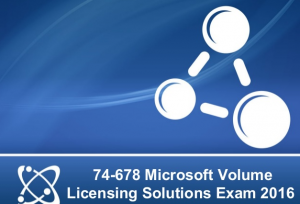QUESTION 1
Your network consists of an Active Directory domain and a DirectAccess infrastructure.
You install Windows 7 on a new portable computer and join the 74-678 Exam computer to the domain.
You need to ensure that the computer can establish DirectAccess connections.
What should you do?
A. Install a computer certificate.
B. Create a new network connection.
C. Enable the Network Discovery firewall exception.
D. Add the computer account to the Network Configuration Operators group.
Correct Answer: A Explanation

Explanation: Certificates The DirectAccess IPsec session is established when the client running Windows 7 and the DirectAccess server authenticate with each other using computer certificates. DirectAccess supports only certificate-based authentication.
DirectAccess Client Configuration Clients receive their DirectAccess configuration through 74-678 Group Policy. This differs from traditional VPN configuration where connections are configured manually or distributed through the connection manager administration kit. Once you have added the computer’s client account to the designated security group, you need to install a computer certificate on the client for the purpose of DirectAccess authentication. An organization needs to deploy Active Directory Certificate Services so that clients can automatically enroll with the appropriate certificates.
QUESTION 2
You have a portable computer named Computer1 that runs Windows 7.
You have a file server named Server1 that runs Windows Server 2008. Server1 contains a shared folder named Share1.
You need to configure Computer1 to meet the 74-678 pdf following requirements:
Ensure that cached files from Share1 are encrypted.
Ensure that files located in Share1 are available when Server1 is disconnected from the network. What should you do?
A.On Server1, encrypt the files in Share1. On Computer1, make Share1 available offline.
B.On Server1, configure BitLocker Drive Encryption. On Computer1, make Share1 available offline.
C.On Computer1, make Share1 available offline and enable encryption of offline files.
D.On Computer1, copy the files from Share1 to the Documents library and configure BitLocker Drive Encryption.
Correct Answer: C Explanation
Explanation:
Offline Files
The Offline Files feature of Windows 7 allows a client to locally cache files hosted in shared folders so that they are accessible when the computer is unable to connect directly to the network resource. The Offline Files feature is available to users of the Professional, Enterprise, and Ultimate editions of Windows 7. You can use the 74-678 Offline Files feature to ensure access when a client computer is out of the office or when a temporary disruption, such as a wide area network (WAN) link failing between a branch office and a head office, blocks access to specially configured shared folders.
Using Sync Center
You can use Sync Center to synchronize files, manage offline files, and resolve synchronization conflicts manually. Sync Center is located within the Control Panel or by typing Sync Center into the Search Programs and Files text box on the Start menu. Clicking Manage Offline Files opens the 74-678 dumps Offline Files. This dialog box is also available using the Offline Files control panel. Using this dialog box, you can disable offline files, view offline files, configure disk usage for offline files, configure encryption for offline files, and configure how often Windows 7 should check for slow network conditions.
QUESTION 3
You have a computer named Computer1 that runs Windows Vista and a computer named Computer2 that
runs Windows 7. You plan to 74-678 migrate all profiles and user files from Computer1 to Computer2.
You need to identify how much space is required to complete the migration.
What should you do?
A. On Computer1 run Loadstate c:\store /nocompress
B. On Computer1 run Scanstate c:\store /nocompress /p
C. On Computer2 run Loadstate \\computer1\store /nocompress
D. On Computer2 run Scanstate \\computer1\store /nocompress /p Correct Answer: B
Explanation: ScanState You run ScanState on the source computer during the migration. You must run ScanState.exe on computers running Windows Vista and Windows 7 from 74-678 vce an administrative command prompt. When running ScanState on a source computer that has Windows XP installed, you need to run it as a user that is a member of the local administrators group.
Space Estimations for the Migration Store When the ScanState command runs, it will create an .xml file in the path specified.
User State Migration Tool USMT 4.0 is a command-line utility that allows you to automate the process of user profile migration. The USMT is part of the 74-678 Windows Automated Installation Kit (WAIK) and is a better tool for performing a large number of profile migrations than Windows Easy Transfer. The USMT can write data to a removable USB storage device or a network share but cannot perform a direct side-by-side migration over the network from the source to the destination computer. The USMT does not support user profile migration using the Windows Easy Transfer cable. USMT migration occurs in two phases, exporting profile data from the source computer using ScanState and importing profile data on the destination computer using LoadState.
Read more: http://www.passitdump.com/74-678.html Pass Microsoft 74-678 exam test quickly and easily at first attempt with best 74-678 exam study materials free download online.
Reference: https://www.microsoft.com/en-us/learning/exam-74-678.aspx
Related: https://www.dumpsdemo.com/microsoft-70-480-exam-pdf/